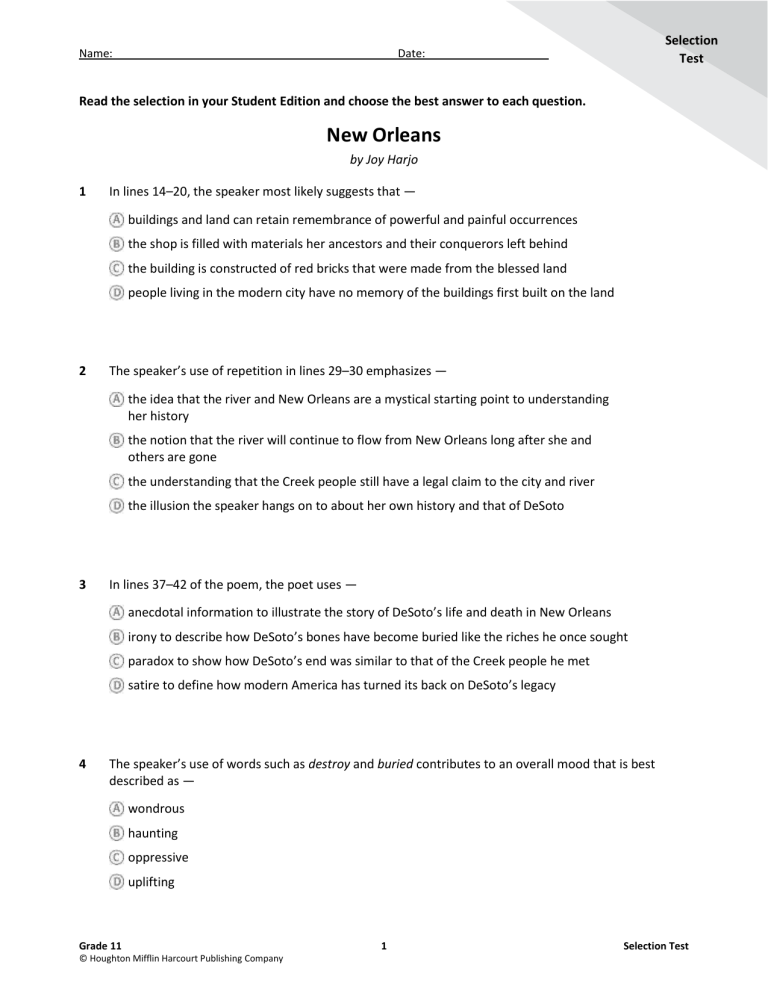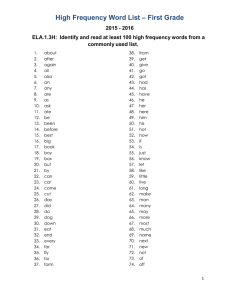
Name: Selection Test Date: Read the selection in your Student Edition and choose the best answer to each question. New Orleans by Joy Harjo 1 In lines 14–20, the speaker most likely suggests that — buildings and land can retain remembrance of powerful and painful occurrences the shop is filled with materials her ancestors and their conquerors left behind the building is constructed of red bricks that were made from the blessed land people living in the modern city have no memory of the buildings first built on the land 2 The speaker’s use of repetition in lines 29–30 emphasizes — the idea that the river and New Orleans are a mystical starting point to understanding her history the notion that the river will continue to flow from New Orleans long after she and others are gone the understanding that the Creek people still have a legal claim to the city and river the illusion the speaker hangs on to about her own history and that of DeSoto 3 In lines 37–42 of the poem, the poet uses — anecdotal information to illustrate the story of DeSoto’s life and death in New Orleans irony to describe how DeSoto’s bones have become buried like the riches he once sought paradox to show how DeSoto’s end was similar to that of the Creek people he met satire to define how modern America has turned its back on DeSoto’s legacy 4 The speaker’s use of words such as destroy and buried contributes to an overall mood that is best described as — wondrous haunting oppressive uplifting Grade 11 © Houghton Mifflin Harcourt Publishing Company 1 Selection Test Name: 5 Date: Selection Test This question has two parts. First, answer Part A. Then, answer Part B. Part A Which statement best describes a central theme of the poem? Historical figures are rarely as important as people make them out to be. Cities provide insight into the shared history of the location where they were built. Individuals who devote a lot of time to understanding a culture’s past become paralyzed by it. Learning about a culture’s past can shape the individual’s experience of the present. Part B Which excerpt from the poem best supports the answer to Part A? . . . I see a blue horse / caught frozen in stone in the middle of / a square. . . . (lines 5–7) Nearby is a shop with ivory and knives. / There are red rocks. . . . (lines 14–15) Maybe his body is what I am looking for / as evidence. To know in another way / that my memory is alive. (lines 58–60) And I know I have seen DeSoto, / having a drink on Bourbon Street, / mad and crazy / dancing with a woman as gold / as the river bottom. (lines 68–72) 6 From the poem, the reader can most reasonably infer that the Creek people — built many of the buildings the speaker visits prevented DeSoto from entering the city welcomed DeSoto when he arrived at the city inhabit the city in a spiritual way for the speaker Grade 11 © Houghton Mifflin Harcourt Publishing Company 2 Selection Test Name: 7 Selection Test Date: Which two quotes from the poem most contribute to the theme that individuals connect to the tragedies of the past by feeling a sense of loss in the present? Nearby is a shop with ivory and knives. / There are red rocks. The man behind the / counter has no idea that he is inside / magic stones. . . . (lines 14–17) . . . It swims out of Oklahoma, / deep the Mississippi River. It carries my / feet to these places: the French Quarter, / stale rooms, the sun behind thick and moist / clouds . . . (lines 23–27) There are ancestors and future children / buried beneath the currents stirred up by / pleasure boats going up and down. (lines 33–35) And knew he was one of the ones who yearned / for something his heart wasn’t big enough / to handle. (lines 47–49) The Creeks knew it, and drowned him in / the Mississippi River / so he wouldn’t have to drown himself. (lines 55–57) 8 The poem “New Orleans” uses vivid language to tell its story. Mark the box that matches each phrase to the correct literary device. . . . blood, / a delta in the skin. . . . (lines 22–23) There are stories here made of memory. (line 36) . . . for shining streets / of beaten gold to dance on with silk ladies. (lines 40–41) graves that rise up out of soft earth in the rain, (line 65) 9 Metaphor Imagery □ □ □ □ □ □ □ □ Which statement best describes what New Orleans means to the speaker? New Orleans is the most important city in the history of the European exploration of North America. New Orleans is a reminder of how greed drove colonial expansion and resulted in tragedy for the Creeks. New Orleans represents all cities in America founded at the expense of the Creeks and other Native peoples. New Orleans is an example of how a place can overcome a tragic past and become a center of wealth. Grade 11 © Houghton Mifflin Harcourt Publishing Company 3 Selection Test Name: Selection Test Date: 10 How does the poet use color in the poem? Cite evidence from the selection to support your response. 11 Read lines 66–67 of the poem. shops that sell black mammy dolls holding white babies. What purpose does this allusion to slavery most likely serve in the poem? It criticizes the shop owners in New Orleans who sell the dolls. It reminds readers that the history of New Orleans is too complex to capture in one poem. It emphasizes for readers that New Orleans has a negative past for other groups as well as for the Creeks. It shifts the main focus of the poem from the suffering of the Creeks to the suffering of black slaves. 12 Which statement best explains why the speaker names famous New Orleans streets and landmarks in the poem? She wants to show she is reliable by demonstrating a thorough knowledge of the city. She wants to tell the reader the exact locations in the city where the historical events described took place. She wants to show how important these places are to readers who may never get to visit New Orleans. She wants to help the reader contrast images of modern New Orleans with the violent history she is describing. Grade 11 © Houghton Mifflin Harcourt Publishing Company 4 Selection Test Name: Selection Test Date: Answer Key: New Orleans Item Number Correct Answer 1 A 2 A 3 B 4 B 5A D 5B C 6 D 7 B, C 8 11 12 ELA.K12.EE.3.1, ELA.11.R.1.1, ELA.11.R.1.4, ELA.11.R.3.1 ELA.11.R.3.1, ELA.11.R.1.3, ELA.11.R.1.4 ELA.11.R.3.1, ELA.11.R.1.1, ELA.11.R.1.3, ELA.11.R.1.4 ELA.11.R.3.1, ELA.11.R.1.1 ELA.11.R.1.2 ELA.11.R.1.2, ELA.11.R.1.1, ELA.K12.EE.1.1 ELA.K12.EE.3.1, ELA.11.R.1.4 ELA.11.R.1.2 Metaphor: blood . . .; There are stories . . . Imagery: for shining streets . . .; graves that rise . . . 9 10 B.E.S.T. Standards B ELA.11.R.3.1, ELA.11.V.1.1 ELA.11.R.1.3, ELA.11.R.1.4 Sample Answer: The poet uses color to appeal to the readers’ sense of sight. For example, in lines 5–6, the poet writes, “a blue horse / caught frozen in stone,” to use the color blue to suggest cold and the idea of a living creature made immobile. In line 3, “tobacco brown bones” implies ELA.K12.EE.1.1, the deep brown of age and the smell of earth. Later in the poem, in line ELA.11.R.1.1, 64, the poet writes of “beaten silver paths” to refer to the steel trolley car ELA.11.R.3.1 rails that carry people back and forth. Her use of color enriches the experience of the poem for readers and strengthens its themes related to past and present. ELA.11.R.3.1, C ELA.11.R.1.3, ELA.11.R.1.4 ELA.11.R.1.3, D ELA.11.R.1.4 Grade 11 © Houghton Mifflin Harcourt Publishing Company 5 Depth of Knowledge 2 2 2 2 2 2 2 3 2 3 3 2 2 Selection Test



